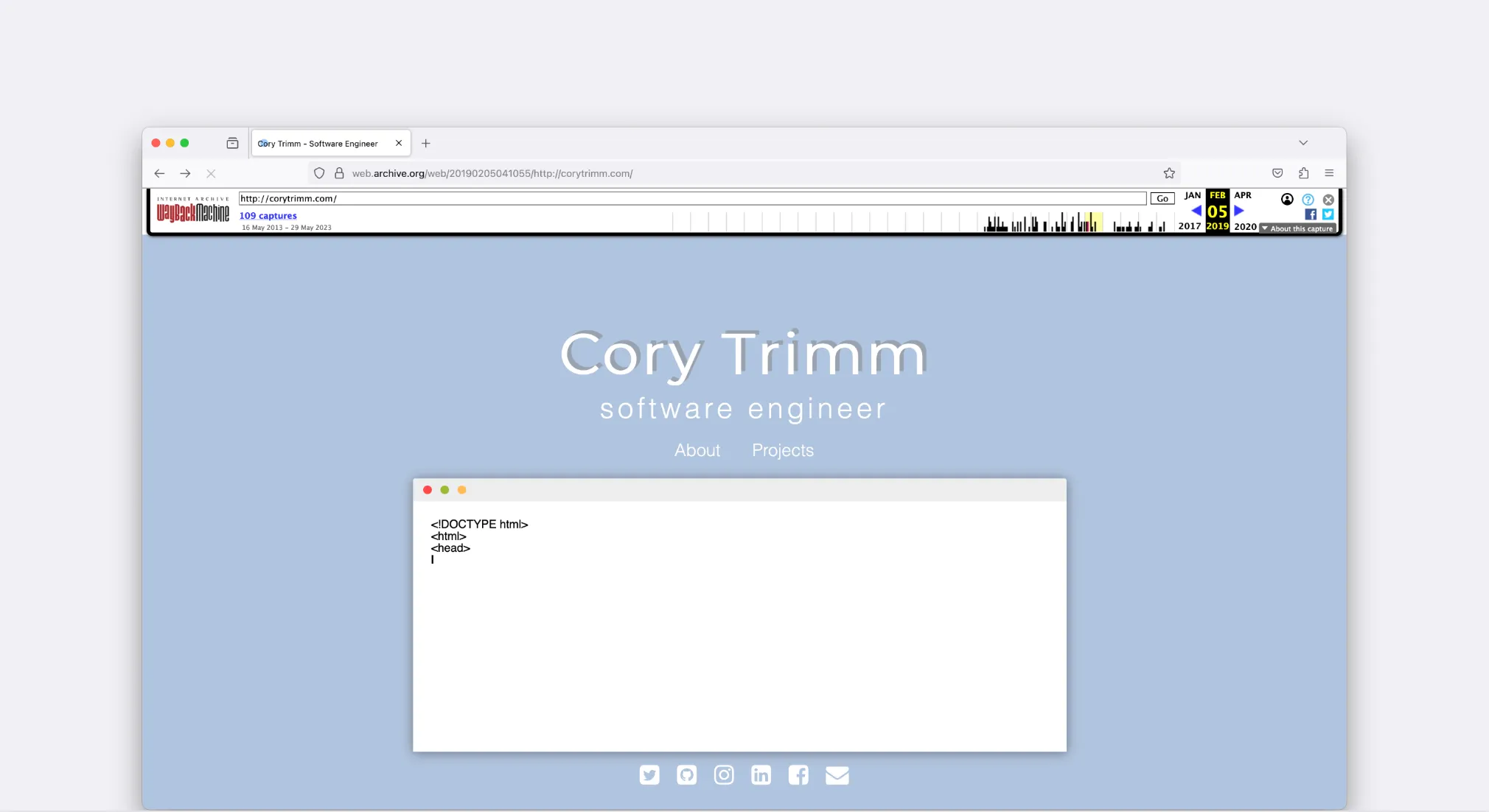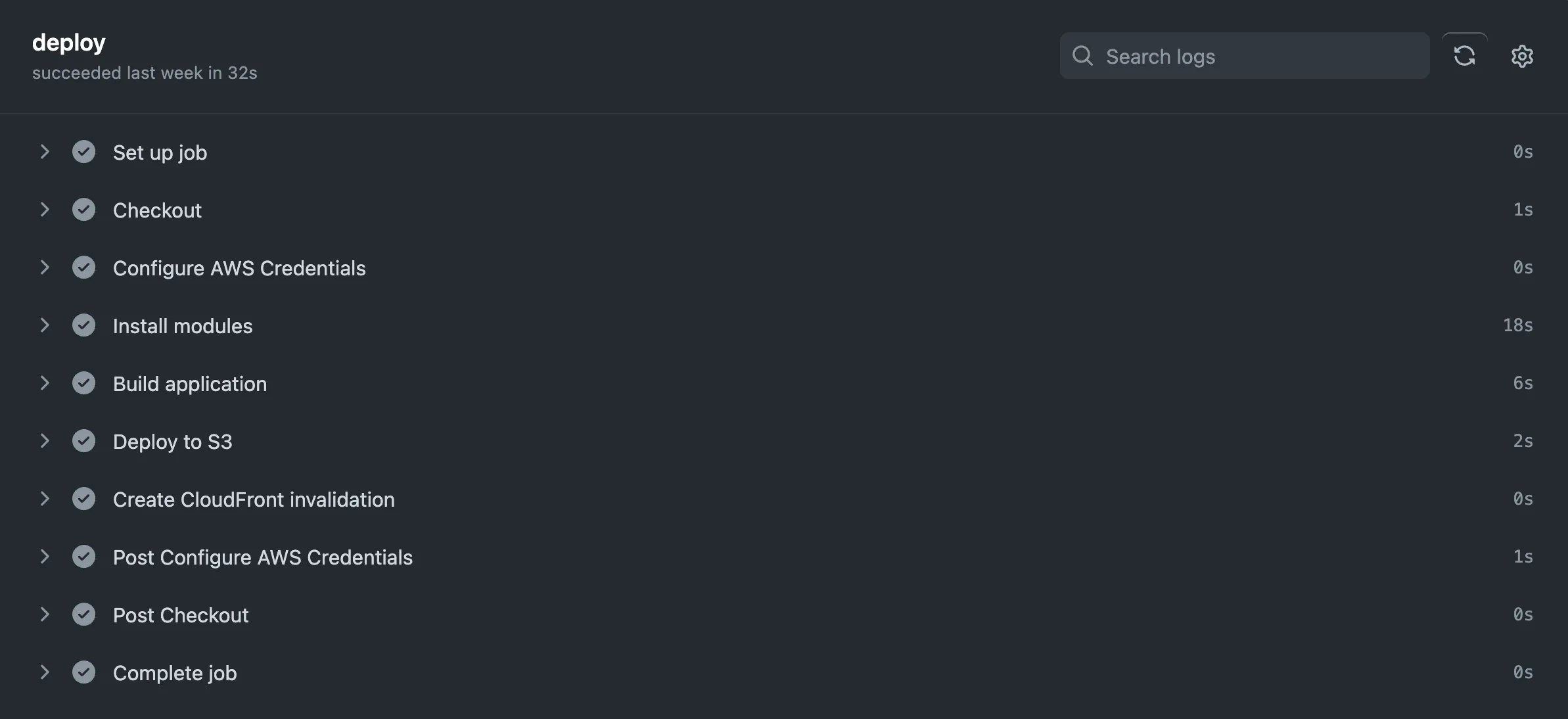Some Background Of How This Came To Be

It had been awhile since I refreshed my personal site (screenshot above - circa 2019). Seeing that I’ve been itching to write more code outside of my day-job, I figured I could put to the test how quickly I could build + deploy a static website from start to finish. I had previously used the same system / set of processes to build & deploy Cabeça de Queijo and Toucan Trips.
How much time does this take to setup?
Honestly, getting Name.com DNS + AWS setup properly to host the site too ~60 minutes - max. Since I had worked out the kinks in the process w/ Cabeça de Queijo this was relatively painless with only one hiccup (setting up a 404 page in CloudFront and in the codebase).
How long does a build/deploy step take?
 Immediately after code is merged into the
Immediately after code is merged into the main branch, the GitHub Action to deploy the site is kicked off.
In total, it takes whopping 41 seconds - of which GitHub Actions adds 10s and installing npm modules is 18s. You can see that by having specific steps in your GitHub Action, you can really nail down what is taking up time.

Limitations
Certainly, as with most technology, there are limitations to what this deployment system can / cannot do. This guide is geared around launching an Astro website. And even tho Astro is relatively new, I found their documentation to be fantastic - as well as the various examples that folks in the ecosystem have produced.
Brief Guide on How to Setup AWS CloudFront with Name.com as the Domain Registry.
Steps -
- Purchase Domain(s) on Name.com
- Sign into the AWS Console
- Navigate to AWS Certificate Manager (ACM)
- Setup a certificate for both
*.domainName.com&&www.domainName.comand with the standard DNS Validation and RSA-2048 Key Algorithm. - Navigate back to Name.com and go to the DNS Setting for the domainName.com
- In order to validate ownership of the domain, copy & paste the DNS Verification Records from the Newly Created Certificate from AWS Certificate Manager into the DNS Management on Name.com (Note - this could take a few mins to validate)
- Now that the domain is validated, we need to setup the remaining AWS Resources (in this case an S3 Bucket and CloudFront).
- Setup the S3 bucket like any other bucket - with
Static Website Hostingdisabled - Setup a CloudFront Distribution in the same region as the S3 Bucket (i.e. us-east-1) in order to make setup easier
- The CloudFront Distribution should use
All Edge Locations,HTTP/2, HTTP/1.1, HTTP/1.0, be connected to theSSL Certificatethat was created earlier (pickable in a dropdown option),TLSv1.2_2021security option,Redirect HTTP to HTTPS, and other setting for theindexpage anderrorpages. - The S3 Bucket Policy needs to be updated to allow the CloudFront Distribution to access it. This can be done by going into the CloudFront Distribution that was just created and then select the
Originstab and select the only entry +Edit. From here, you will setupOrigin access control settings (recommended)and thenCreate control settingand thenSaveto create a linkage between CloudFront and the S3 Bucket. - Now, we need to ensure there is a CI/CD pipeline from GitHub.com to the AWS resource(s) - in this case, we built a static website built with Astro and a CI/CD workflow on GitHub.com as the source code repository location.
- The code below is the GitHub Action required to make the code build & deploy when something is
mergedorpushedto themainbranch. Step 14 is where the various Secrets -
name: Deploy Website to Amazon S3
on:
push:
branches:
- main
jobs:
deploy:
runs-on: ubuntu-latest
steps:
- name: Checkout
uses: actions/checkout@v3
- name: Configure AWS Credentials
uses: aws-actions/configure-aws-credentials@v1
with:
aws-access-key-id: ${{ secrets.AWS_ACCESS_KEY_ID }}
aws-secret-access-key: ${{ secrets.AWS_SECRET_ACCESS_KEY }}
aws-region: us-east-1
- name: Install modules
run: npm ci
- name: Build application
run: npm run build
- name: Deploy to S3
run: aws s3 sync --delete ./dist/ s3://${{ secrets.BUCKET_ID }}
- name: Create CloudFront invalidation
run: aws cloudfront create-invalidation --distribution-id ${{ secrets.DISTRIBUTION_ID }} --paths "/*"- As you can see from the
.github/workflows/deploy.ymlfile above, you need a few secrets stored in GitHub.com on the repository. You can access this Secret Store under theSettingstab of your repo. (NOTE - In thedeploy.ymlfile above, theBUCKET_IDis just the plain-text name of your bucket -project-name-frontend) - In the AWS Console, navigate to the IAM Policies Page - and with the policy below -
{
"Version": "2012-10-17",
"Statement": [
{
"Sid": "VisualEditor0",
"Effect": "Allow",
"Action": [
"s3:PutObject",
"s3:ListBucket",
"s3:DeleteObject",
"cloudfront:CreateInvalidation"
],
"Resource": [
"arn:aws:cloudfront::177283549651:distribution/[GET_THE_CLOUDFRONT_DISTRIBUTION_FROM_THE_MAIN_PAGE]",
"arn:aws:s3:::[S3_BUCKET_NAME]*",
"arn:aws:s3:::[S#_BUCKET_NAME]"
]
}
]
}- The policy, when added to an IAM Entity (i.e. User) will allow for various operations that are required for CI/CD.
- Create a new IAM User with the newly created policy and navigate to the
Security Credentialstab to create a newAccess Key. - Copy and paste those values from the AWS Console into the Github Secret Store for you repository.
- Navigate to both the S3 Bucket and the CloudFront Distribution to copy & paste the relevant secrets (i.e.
BUCKET_ID&DISTRIBUTION_ID) into GitHub.com Secret Store. - We’re nearly there, now we need to create a Route 53 Hosted Zone (AWS’ name server tool) in order to handle requests to both
*.domainName.com&www.domainName.com. - Create a Hosted Zone for your
domainName.comand create bothAandAAAArecords for both*.domainName.comandwww.domainName.com(in total, 4 new records). You will doSimple RoutingandAlias to CloudFront Distributionand select your new CloudFront Distribution in the typeahead/dropdown. - Now that there is a “new” name server (Route 53), we need to change the Name Server config on Name.com
- Copy and paste the AWS Route 53 Name Servers from the
Hosted Zone Detailspane into Name.com. - Save the new AWS Name Server Records & delete the old
[ns1-ns4].name.comname server records- NOTE - If you have a custom email / simple email forwarding already setup on Name.com (via a MX DNS record), it will break it since Name.com is now longer the name server.
- As mentioned above, if you want to setup email forwarding for any email that goes to
*@domainName.comto your personalemail@provider.com, utilize a tool like improvMX.com. It takes ~5 minutes to setup and you can even send emails from*@gmail.combut make them look like their from*@domainName.com.
If there are issues with the above, ensure that your DNS has propagated with a tool like this.
Note - If you have a multipage website, be sure to create a CloudFront Function in order to handle redirects properly.